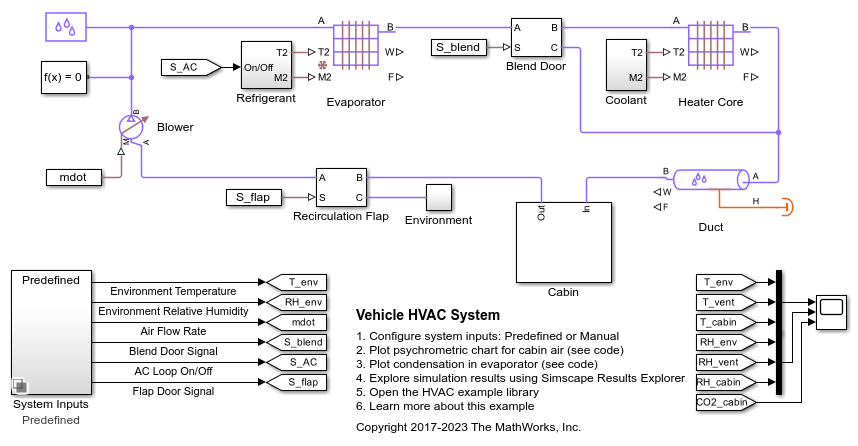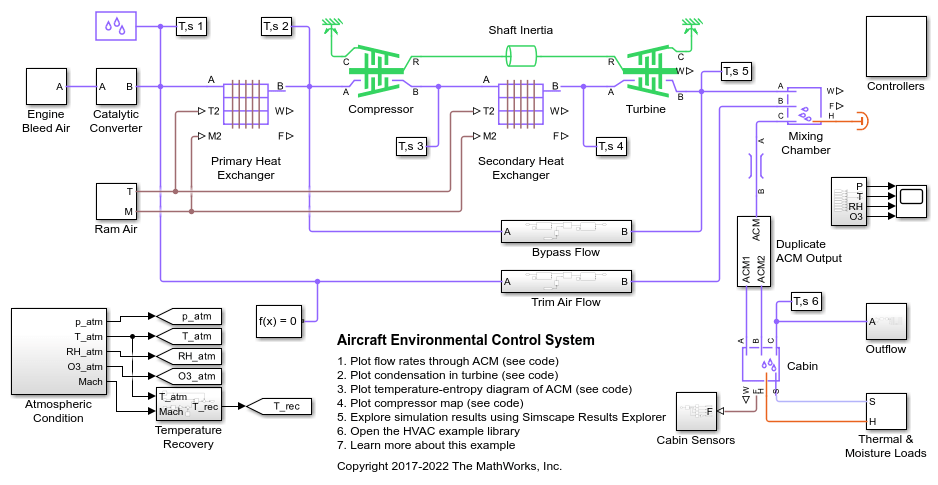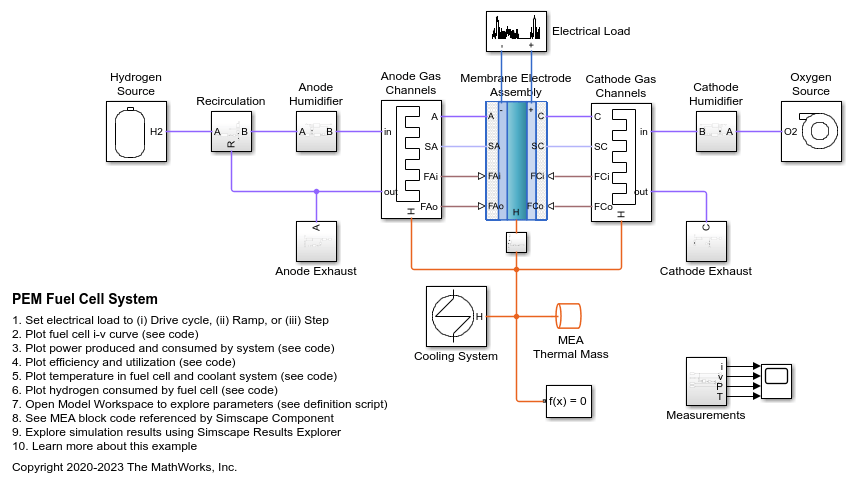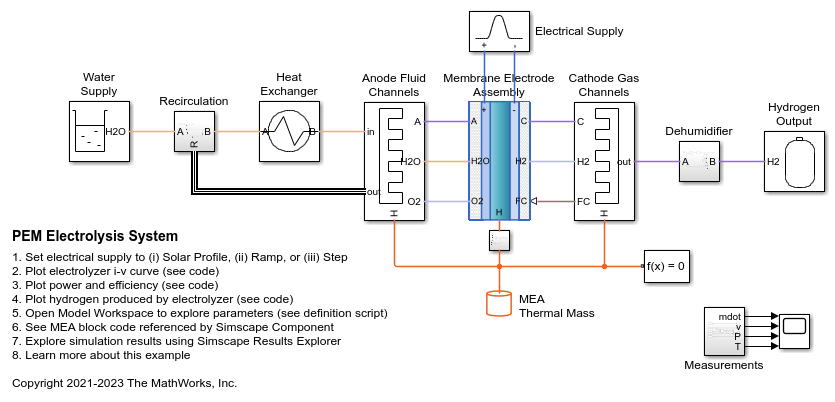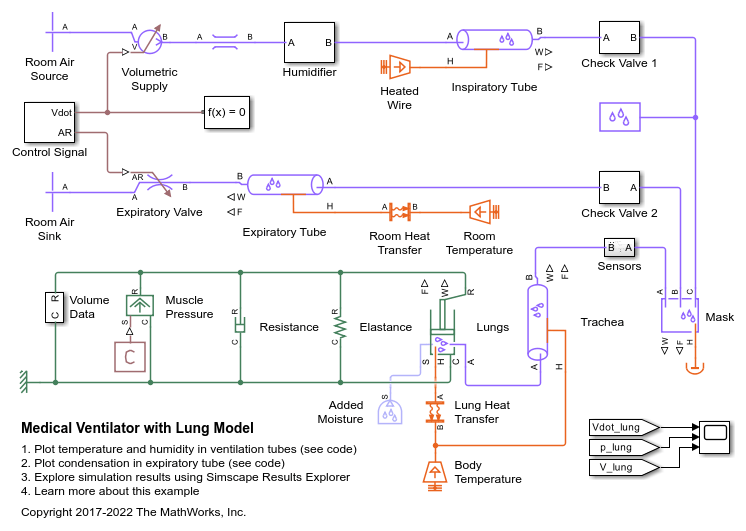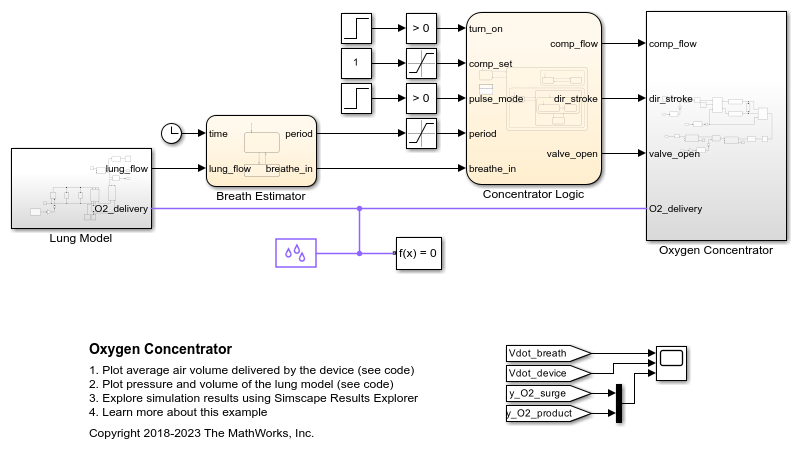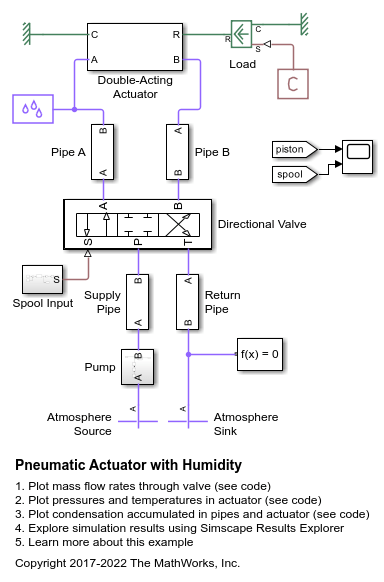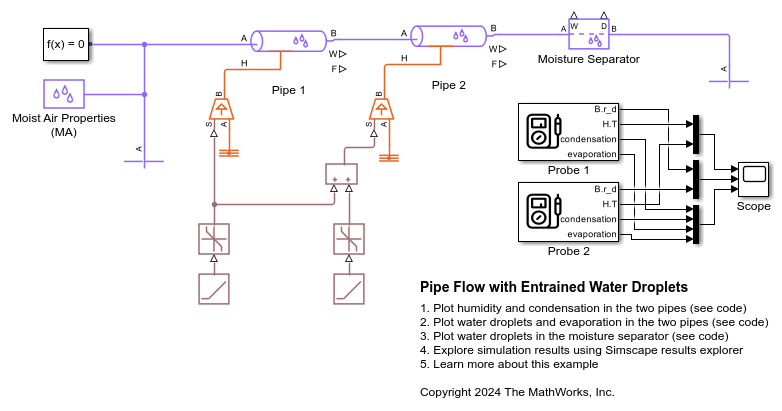Moist Air Systems
Explore examples that illustrate modeling, control, and simulation of moist air systems.
Featured Examples
Vehicle HVAC System
Models moist air flow in a vehicle heating, ventilation, and air conditioning (HVAC) system. The vehicle cabin is represented as a volume of moist air exchanging heat with the external environment. The moist air flows through a recirculation flap, a blower, an evaporator, a blend door, and a heater before returning to the cabin. The recirculation flap selects flow intake from the cabin or from the external environment. The blender door diverts flow around the heater to control the temperature.
Aircraft Environmental Control System
Models an aircraft environmental control system (ECS) that regulates pressure, temperature, humidity, and ozone (O3) to maintain a comfortable and safe cabin environment. Cooling and dehumidification are provided by the air cycle machine (ACM), which operates as an inverse Brayton cycle to remove heat from pressurized hot engine bleed air. Some hot bleed air is mixed directly with the output of the ACM to adjust the temperature. Pressurization is maintained by the outflow valve in the cabin. This model simulates the ECS operating from a hot ground condition to a cold cruise condition and back to a cold ground condition.
PEM Fuel Cell System
Model a proton exchange membrane (PEM) fuel cell stack with a custom Simscape™ block. The PEM fuel cell generates electrical power by consuming hydrogen and oxygen and producing water vapor. The custom block represents the membrane electrode assembly (MEA) and is connected two separate moist air networks: one for the anode gas flow and one for the cathode gas flow.
PEM Electrolysis System
Model a proton exchange membrane (PEM) water electrolyzer with a custom Simscape™ block. The PEM electrolyzer consumes electrical power to split water into hydrogen and oxygen. The custom block represents the membrane electrode assembly (MEA) and is connected to a thermal liquid network and two separate moist air networks: the thermal liquid network models the water supply, the anode moist air network models the oxygen flow, and the cathode moist air network models the hydrogen flow.
Medical Ventilator with Lung Model
Models a positive-pressure medical ventilator system. A preset flow rate is supplied to the patient. The lungs are modeled with the Translational Mechanical Converter (MA), which converts moist air pressure into translational motion. By setting the Interface cross-sectional area to unity, displacement in the mechanical translational network becomes a proxy for volume, force becomes a proxy for pressure, spring constant becomes a proxy for respiratory elastance, and damping coefficient becomes a proxy for respiratory resistance.
Oxygen Concentrator
Models an oxygen concentrator device coupled to a lung model. One of the two sieves filters out nitrogen from the air to produce concentrated oxygen in the product tank. The two sieves switches periodically so that while one sieve is filtering, the other can purge the adsorbed nitrogen. When the lung model inhales, some of the oxygen-rich gas from the product tank is mixed into the inspiratory flow.
Pneumatic Actuator with Humidity
How the Simscape™ Foundation Library moist air components can be used to model a pneumatic actuator operating in a humid environment. The Directional Valve is a subsystem composed of four Variable Local Restriction (MA) blocks, and the Double-Acting Actuator is a subsystem composed of two Translational Mechanical Converter (MA) blocks in opposite mechanical orientation.
Pipe Flow with Entrained Water Droplets
Model water droplets that are entrained in a moist air flow. When water vapor condenses in a moist air block, the condensate can become entrained in the moist air flow as small suspended water droplets or ice crystals. In real world systems this can appear as fog. The moist air blocks assume the droplets are small aerosol particles, and take up negligible space. Thus water droplets do not contribute to the specific volume or density of the moist air flow. Furthermore, water droplets are assumed not to affect moist air transport properties such as dynamic viscosity and thermal conductivity. However, water droplets do contribute to the enthalpy and thermal mass of the moist air flow and can therefore affect the temperature variation of the flow. In addition, water droplets can evaporate back into the moist air flow downstream when the relative humidity drops back below saturation. The latent heat for re-evaporation is absorbed from the moist air flow which lowers the moist air temperature.
MATLAB Command
You clicked a link that corresponds to this MATLAB command:
Run the command by entering it in the MATLAB Command Window. Web browsers do not support MATLAB commands.

Select a Web Site
Choose a web site to get translated content where available and see local events and offers. Based on your location, we recommend that you select: .
You can also select a web site from the following list
How to Get Best Site Performance
Select the China site (in Chinese or English) for best site performance. Other MathWorks country sites are not optimized for visits from your location.
Americas
- América Latina (Español)
- Canada (English)
- United States (English)
Europe
- Belgium (English)
- Denmark (English)
- Deutschland (Deutsch)
- España (Español)
- Finland (English)
- France (Français)
- Ireland (English)
- Italia (Italiano)
- Luxembourg (English)
- Netherlands (English)
- Norway (English)
- Österreich (Deutsch)
- Portugal (English)
- Sweden (English)
- Switzerland
- United Kingdom (English)
Asia Pacific
- Australia (English)
- India (English)
- New Zealand (English)
- 中国
- 日本Japanese (日本語)
- 한국Korean (한국어)
